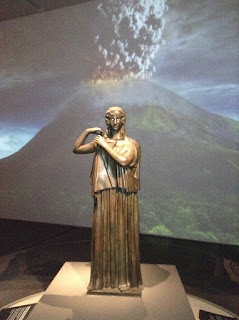In the year 79 AD the Italian resort town of Pompeii, and its sister Herculean, were destroyed by the eruption of Mount Vesuvius. It has become one of the most famous volcanic eruptions of all time, and one of the most well known mass tragedies of human life
The carnage and sadness has been brought to Toronto through an exhibition at the ROM. It's the Holidays, let's go celebrate!
On that day 2,000 people lost their lives, many to suffocating ash, some to the boiling pyroclastic flows from the volcano. What the ROM always does well is giving you an opportunity to see beyond the numbers and get an impression of what the town was, before and after the tragedy, and who it was that lived there
The first part of the exhibit gives us glimpses of what life in Pompeii was like before the eruption. Most of the pieces are arranged to show us the bustling, living town that was kind of the little jewel of the Roman empire at the time. They loved their theatre and they had two, both of which would have been as good as any in Rome at the time
Theatre was not their only form of entertainment. Of course they loved their gladiators and they sported a coliseum long before Rome did Here is some gladiator armour excavated from the site
But it wasn't all violence in old Pompeii, on no sir. You gots to have some sex mixed in with that, and golly gee, did they ever lover their sex. Prostitution was legal in the pre Christian Roman empire and the citizens of Pompeii were very much into expressing their legal rights. There were many advertisements for brothels and even in the homes of regular citizens you could find art depicting a wide variety of, er, adult fantasies, like this nymph being seduced by a satyr
The people of the town were fairly wealthy by common standards but in the long run they were just people, into their gardens and the bounty of the sea on which they feasted
Who knows what the future had in store for the city of Pompeii. Probably it would have grown, it would have lasted, maybe as a resort town you could visit today. But Vesuvius had other plans. In the course of a day the volcano wiped out the city. And years later it was rediscovered, literally dug out from a mountain of ash. Ash that fell down from the sky, burying all those humans, hardening, remaining intact as time dissolved the bodies and left their impressions so that archeologists could pour in plaster, and in a sense, reanimate the citizens of Pompeii
Some sought shelter in wine cellars yet were still overcome by the ash. Some left their shelter when the ash seemed to stop falling, only to be caught by a pyroclastic flow. Humans, overcome by something greater than themselves
Some seemed to be able to come to peace with their fate, and simply waited for the darkness to take them
Humans were not the only ones to fall to the volcano. The people of Pompeii loved their dogs, as evidenced by this famous entranceway tile. Cave carnem it says. Beware of dog
And beware you should be. He guarded his house right till the end.
All sad stuff, much of which I knew, or had read about. But the exhibit brought the reality home. By giving me a view of Pompeii as a living, vibrant city, I truly felt the tragedy of its death. Sad that all those people died. But the remnants they left behind, even the impressions of their own bodies, really serves to remind us of their lives, lived so long ago
















No comments:
Post a Comment